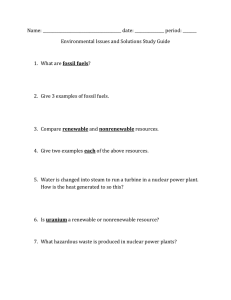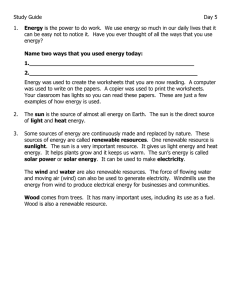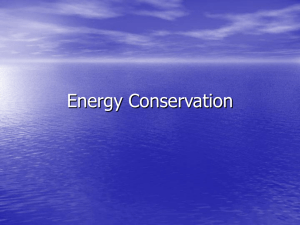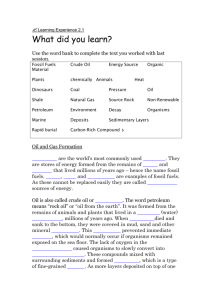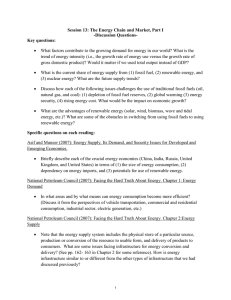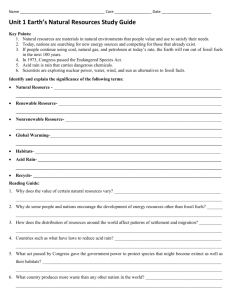UNDERSTANDING EARTH’S RESOURCES Objectives
advertisement
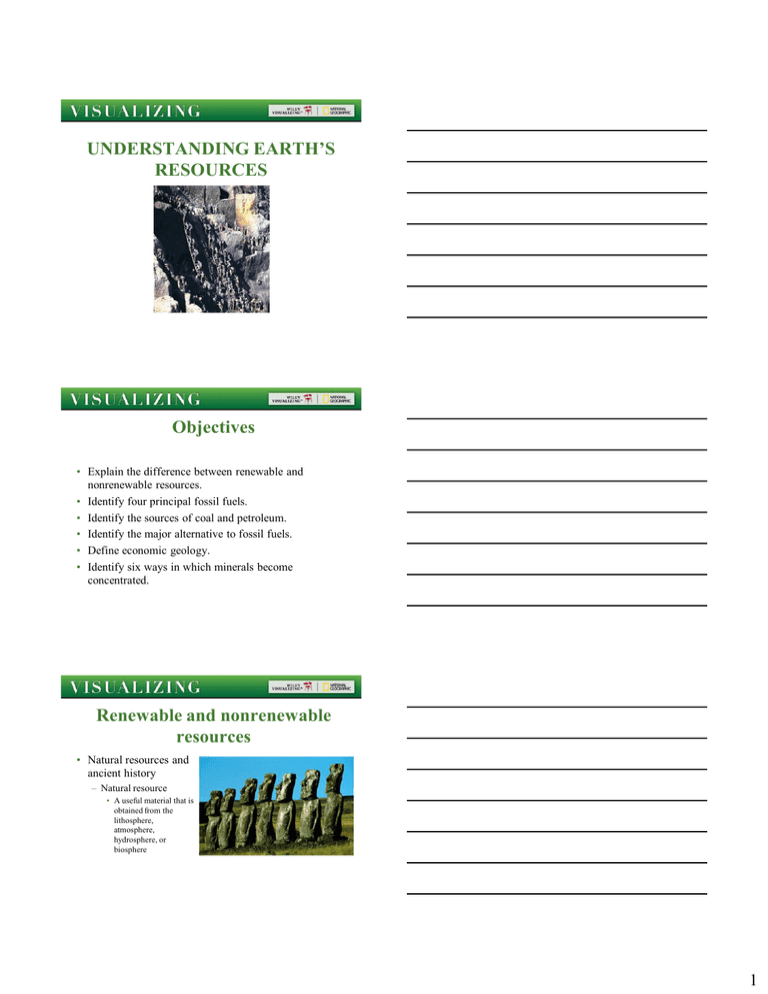
UNDERSTANDING EARTH’S RESOURCES Objectives • Explain the difference between renewable and nonrenewable resources. • Identify four principal fossil fuels. • Identify the sources of coal and petroleum. • Identify the major alternative to fossil fuels. • Define economic geology. • Identify six ways in which minerals become concentrated. Renewable and nonrenewable resources • Natural resources and ancient history – Natural resource • A useful material that is obtained from the lithosphere, atmosphere, hydrosphere, or biosphere 1 Renewable and nonrenewable resources • Renewable resource – A resource that can be replenished or regenerated on the scale of a human lifetime • Nonrenewable resource – A resource that cannot be replenished or regenerated on the scale of a human lifetime Energy Resources • Resources and modern society – North America has the highest per capita usage of energy resources. 2 • Fossil fuel Fossil Fuels – Combustible organic matter – Trapped in sediment or sedimentary rock • Peat – A biogenic sediment – Accumulation and compaction of plant remains from bogs and swamps – Carbon content of about 25% • Coal – A combustible rock formed by the compression, heating, and lithification of peat. – 50-95% carbon Fossil Fuels 3 Lignite (low rank coal) in Tertiary sediments of North Dakota Fossil Fuels Fossil Fuels • Petroleum – Naturally occurring gaseous, liquid, and semi solid substances that consist chiefly of hydrocarbon compounds • Oil – The liquid form of petroleum • Natural gas – The gaseous form of petroleum 4 Fossil Fuels Unconventional fossil fuels • Tar sands – A sediment or sedimentary rock in which the pores are filled with dense, viscous, asphalt like oil 5 Unconventional fossil fuels • Oil shale – A fine grained sedimentary rock with a high content of kerogen Fossil Fuels • Relying on fossil fuels – Most projections indicate oil production will peak and begin to decrease before 2020. – It will become necessary to place greater emphasis on other sources of energy besides fossil fuels Renewable Energy Sources • Power from sun, wind, and water – Solar energy is 10,000 times greater than the sum of all human energy demands… (much more abundant than wind, tidal, etc.) – But the best available solar cells are still too costly and inefficient for most uses 6 Renewable Energy Sources • Power from sun, wind, and water – Biomass energy • Any form of energy that is derived from plant life • Includes fuel wood, peat, animal dung, and agricultural wastes, ethanol – Wind turbines • Still expensive, but likely that their cost will soon be competitive with the cost of coal burning electric power plants Renewable Energy Sources • Power from sun, wind, and water – Hydroelectric energy • Electricity generated by running water – Hydrogen • Can be used to power fuel cells • No place to mine hydrogen (must be converted from water, which uses as much energy as it produces) Renewable Energy Sources • Nuclear and geothermal power – Nuclear reactors explore the energy-producing process called radioactive decay – Geothermal energy used by humans come from hydrothermal reservoirs, • These are underground systems of hot water or steam • They circulate in fractured or porous rock 7 Renewable Energy Sources Temporary storage of radioactive waste Yucca Mountain-approved for permanent storage in 2002, but terminated in 2009. Mineral Resources • Ore – A deposit from which one or more minerals can be extracted profitably • Finding and assessing mineral resources – Nonrenewable, countries that can meet their need today may not be able to in the future – Uneven distribution of exploitable deposits mean no nation is self sufficient – Shift of mineral exploration and production away from the industrialized nations toward less developed countries Mineral Resources 8 Mineral Resources • How mineral deposits are formed – – – – – – Hydrothermal Metamorphic Magmatic Sedimentary Placer Residual Mineral Resources Mineral Resources 9 Mineral Resources • Will we run out? – Many geologist fear that shortages of nonrenewable resources will hamper development – Shortages of energy resources are more likely to affect us in the short run 10
